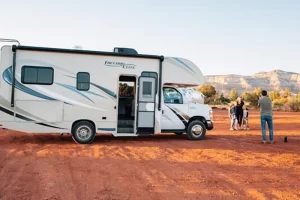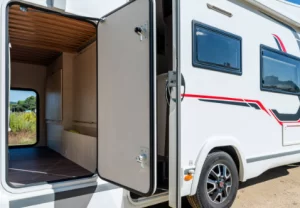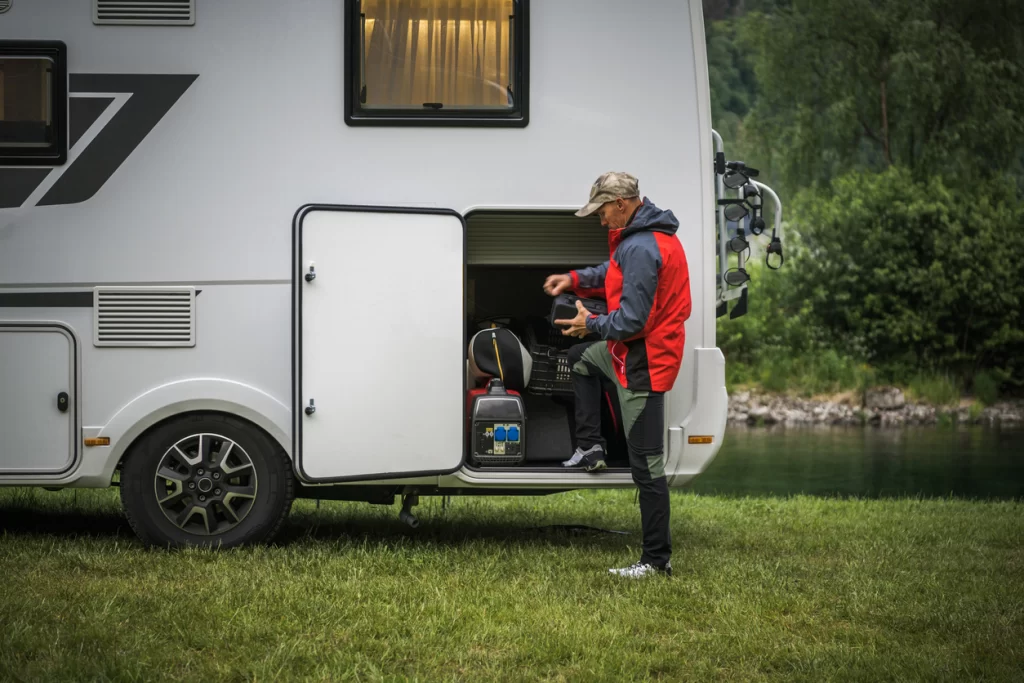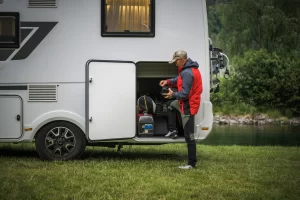You’re all set to take your RV on a long-haul adventure to new locations, so it’s probably a good idea to bring a lot of items along with you––everything you can think of to ensure a comfortable and safe journey. The problem is: where do you store it all?
Travelling in an RV is a great past-time that can enrich the spirit and provide endless hours of entertainment. But there is a right and a wrong way to travel. It’s not as simple as packing your home on wheels to the rafters with your baggage, accessories and modern conveniences. Weight distribution is a major issue when navigating the roads in a massive RV or motorhome, so having safe and adequate storage is essential.
This article will delve into the stats about external storage compartments on Class A, Class B and Class C RVs––what are the major differences, what compartments go where, what can you fit in all of them, and what your particular road trip might require. But first, let’s identify the RV size you’re looking to travel with.
Class A, B, and C RVs: A Quick Size Comparison
When it comes to identifying the main difference between Class A, B, and C RVs, it all comes down to three major components: size, construction, and driving experience.
Class A Motorhomes

A Class A RV is essentially a home on wheels. It is the largest and most luxurious type of motorhome available. Think of it as a bus transformed into a luxurious living space.
Key Characteristics:
- Built on a commercial truck or bus chassis: This provides a sturdy foundation for the inside components.
- Spacious interior: Offering multiple slide-outs, large living areas, full-sized kitchens, and often multiple bathrooms.
- Amenities: Can include features like washers and dryers, residential-sized refrigerators, and even fireplaces.
- Driving: Due to their size, driving a Class A RV often requires a commercial driver’s license (CDL), depending on its weight and dimensions.
Essentially, Class A RVs are designed for those who want the ultimate in comfort and space while traveling. They offer a level of luxury comparable to a small house.
Class C Motorhomes

A Class C RV is a type of motorhome that offers a balance between size, amenities, and maneuverability. It is larger than a Class B but slightly smaller than a Class A.
Key Characteristics:
Built on a commercial truck chassis: This provides a sturdy base while maintaining a more compact size compared to Class A RVs.
- Cabover design: A distinctive feature is the sleeping or storage area above the cab, which adds extra space.
- Amenities: Includes basic kitchen, bathroom, and living areas, often with slide-outs for expanded space.
- Driving: Easier to maneuver than a Class A, making it suitable for drivers with standard licenses.
Class C RVs are a popular choice for families or couples seeking a comfortable and versatile camping experience. They offer a good blend of features and driving ease.
Class B Camper Vans

A Class B RV, often referred to as a camper van, is the smallest of the three main RV types. It’s built on a commercial van chassis, giving it a compact and nimble design.
Key Characteristics:
Compact size: Easy to maneuver and park.
Fuel efficiency: Generally better fuel economy compared to larger RVs.
Amenities: Includes basic kitchen, bathroom, and sleeping areas, often with space-saving features.
Driving: Similar to driving a van, making it accessible to most drivers.
Class B RVs are ideal for couples or solo travelers who prioritize mobility and flexibility. They offer a comfortable and convenient way to explore without sacrificing space.
As the external storing options for Class B vehicles tend to be few and far between, we’ll focus on Class A and Class C only.
Maximizing Your Motorhome’s Storage
As mentioned, Class A motorhomes offer unparalleled luxury and comfort for extended travels, while Class C RVs are great for more comfortable, middle-of-the-road journeys. Either way, each option comes with the challenge of efficiently storing all your belongings––and fortunately, both are designed with ample storage compartments, both inside and out.
Let’s first delve into the world of Class A motorhome storage and explore how to make the most of every cubic inch.
External Storage Compartments on Class A RVs
Class A motorhomes are renowned for their spaciousness, and that extends to their external storage capabilities. These compartments are essential for storing bulky items, outdoor gear, and other belongings that you don’t want inside your living space. Here’s a breakdown of the common types:
Basement Compartments
The workhorse of external storage, these are large, compartmentalized areas located beneath the living area of the RV. They’re typically accessed by lifting heavy, gas-assisted lids. Basement compartments can accommodate a wide range of items, from camping gear and outdoor furniture to generators and power cords.
A variation of basement compartments, pass-through storage offers uninterrupted space across the width of the RV, perfect for long items like kayaks or bikes.
Exterior Pass-Through Storage

These compartments, designed for long items, span the entire width of the motorhome, making them ideal for storing bulky items like kayaks, bikes, or even golf clubs. They can conveniently be accessed from either side of the RV, making loading and unloading easier. However, it is crucial to distribute weight evenly in these compartments to maintain the RV’s balance.
Exterior Storage Bins
These smaller compartments are typically found on the exterior walls of the RV and offer additional storage space for smaller items. They can typically be found near the entry door, slide-outs, or in the rear of the RV of most models. And they are perfect for storing items like hoses, leveling blocks, or cleaning supplies.
Additional Storage Options
- Roof racks: While not technically a compartment, roof racks provide valuable storage space for items like kayaks, bikes, or cargo carriers.
- Rear cargo racks: Some Class A RVs offer rear cargo racks for additional storage capacity.
External Storage Compartments on Class C RVs
While Class C motorhomes offer a balance between size and amenities, they often have more limited external storage compared to their Class A counterparts. However, they still provide essential storage options for outdoor gear and equipment.
Basement Compartments (if available): Some larger Class C models might feature limited basement storage, similar to Class A RVs, but this is less common. When present, they are typically smaller and offer less storage capacity.
Exterior Storage Bins: These are the most common type of external storage on Class C RVs. They are typically located on the sides or rear of the vehicle and can vary in size and number depending on the model.
Overhead Storage: While not technically an external compartment, the overhead cabover area in Class C RVs can be used for storage, especially when not in use as a sleeping area.
What to Store in Your RV’s External Storage Compartments
Now that you’ve got the lowdown on which RV models come equipped with what storage capabilities, you’re ready to hit the road. Still looking for extra space in your ride? Leisure Coachworks offers internal, external and custom upgrade options for your trailer or RV.
While the types of items you can store in your RV’s external storage compartments largely depend on the size and accessibility of the compartments, here are some common items you can pack up into your Class A or your Class C motorhome:
Camping Gear
Outdoor furniture: Chairs, tables, umbrellas
Grills and cooking equipment: Portable grills, camp stoves, cookware
Tents and canopies: For additional sleeping or shade
Sports equipment: Bikes, kayaks, paddleboards, fishing gear
Outdoor games: Cornhole, bocce ball, frisbees
Vehicle Accessories
Generator: For additional power
Awning and poles: For shade and protection
RV covers: For protection from the elements
Carriage or bike racks: For transporting additional vehicles
Leveling blocks and ramps: For stabilizing your RV
Household Items
Outdoor living essentials: Patio cushions, rugs, lanterns
Cleaning supplies: Hoses, brooms, mops, cleaning chemicals
RV maintenance items: Water hoses, sewer hoses, power cords
Seasonal items: Christmas decorations, winter clothing
Bulkier items: Luggage, suitcases, storage bins
And remember to always check your RV’s owner’s manual for specific recommendations and weight limits for your external storage compartments.
For more information on how you can upgrade your trailer or RV with exterior storage compartments––or for any other parts and service needs, visit Leisure Coachworks.








